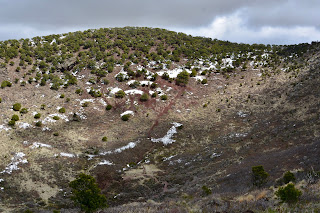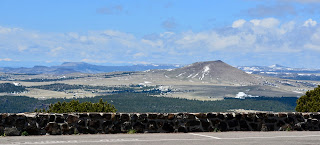Blog for May 3, 2017
About 60,000 years ago, Capulin Volcano was built up over 1,300 feet above the surrounding plain by fountains of ash and lava. Scores of other surrounding peaks and hills were built during the same period of volcanism (who knew that northeastern New Mexico was built by volcanism?!). Because Capulin’s three lava flows erupted from vents at the base of the mountain, the peak retained a very symmetrical cone shape. In the center of the cone lies the original crater.
From the Visitor Center a 2-mile road winds up the mountain to a parking lot just below the crater rim.
Capulin Volcano is 30-miles east of Raton.
Capulin’s birth occurred toward the end of a period of regional volcanic that began 9 million years ago.
From the parking lot at the rim of the volcano you can see hills, peaks, and…
other formations from this period throughout the 8,000-square-mile Raton-Clayton Volcanic Field.
Parking lot at the rim of the crater.
The loop trail around the rim begins and ends at the parking lot. There were still some patches of snow covering the trail.
From the rim looking down into the crater. At its highest point, the rim it is 8,182ft above sea level.
Ten miles to the southeast lies Sierra Grande, the largest of the volcanoes.
The trail affords continuous 360-degree views of the surrounding plains and mountains. Supposedly, on a clear day, you can see Colorado, Oklahoma and Texas.
A half-mile trail drops into the crater.
Lunch spot on the rim of the crater.
Lunch view. Scattered volcanic hills and mountains break up the; endless expanse.
After lunch we hiked the Boca Trail down below by the Visitor Center. In addition to a dead cow carcass (we’ll spare you) we came across this chimney that an early park superintendent had built for a campground fireplace.
Back at theVisitor Center, (yes, they know about the dead cow, but the owning rancher has to come and remove it) we had a lively conversation with Ranger Diana Hicks who was a font of information about volcanism and the surrounding area.
Five miles from Capulin Volcano National Monument is the town of Folsom and and Folsom Man Territory. In 1908, local cowboy George McJunkin, a former slave, made one of the most important archaeological discoveries in US history near the tiny town of Folsom. Spotting some strange bones in Wild Horse Arroyo, he realized that these were an extinct species of bison McJunkin mentioned his find to various people, but not until 1926-28 was the site properly excavated.
Until then, scientists thought that humans had inhabited North America for, at most, 4000 years. With this single find, the facts about the continent’s ancient inhabitants had to be completely revised. Subsequent excavations found stone arrowheads in association with extinct bison bones thought to date from 8000 BC. These Paleo-Indians became known as Folsom Man. Recent dating techniques suggest that these artifacts are in fact 10,800 years old, among the oldest discovered on the continent, although it’s now clear that people have lived in the Americas for even longer.
Today’s combined hike”
Length - 3.08 miles
Duration - 1 hour, 53 minutes
Elevation gain - 820 feet (103 floors on the Fitbit)















It was a darned good sight seeing Folsom Man on the trail again. However, that ice makes it look like it might be a bit slippery, hence, dangerous.
ReplyDeleteYou sure cleaned up those bones in a good way for the archeologists to find them as being really old. Congratulations!
Oak Brook Man